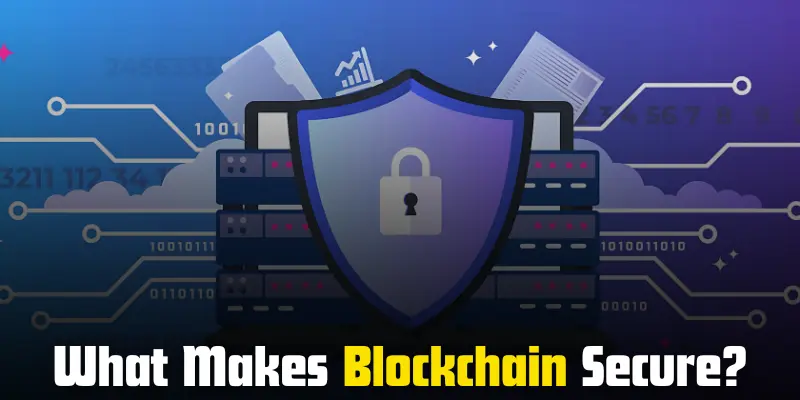How Blockchain Security Features Safeguard Your Digital Transactions
Published: 10 Mar 2025
Have you ever wondered how blockchain manages to keep transactions secure without a central authority? Many people are confused by the concept of blockchain security. But with its built-in features like cryptographic encryption and decentralized validation, blockchain has become one of the safest ways to exchange data and conduct business today.
Introduction
Blockchain security features are one of the key reasons this technology has gained so much attention in recent years. Unlike traditional systems, blockchain doesn’t rely on a central authority to keep things safe. Instead, it uses powerful features like cryptography, decentralization, and transparency to ensure that every transaction is secure and tamper-proof.
Whether it’s keeping your data safe from hackers or ensuring that digital transactions are trustworthy, blockchain offers solutions that protect users from common risks. In this article, we’ll explore how these security features work and why they make blockchain one of the most secure technologies available today.
What Makes Blockchain Secure?

Blockchain technology is secure due to its core features: decentralization, immutability, and transparency. Let’s break down each of these features and see how they contribute to blockchain’s strong security.
Decentralization
- In blockchain, there is no single point of control. The system is spread across many computers (or nodes) around the world.
- This means if one part of the network fails or is attacked, the rest of the system remains secure and functional.
- Example: Traditional Bank (Centralized) – A bank has one main system that controls all accounts. If hackers attack the bank, they can access all user information.
- Example: Blockchain Network (Decentralized) – In a blockchain, no single entity controls the system. Each transaction is recorded across all computers, making it much harder to hack or alter.
Immutability
- Once data is added to the blockchain, it cannot be changed or deleted. This is what makes blockchain a reliable record-keeping system.
- This ensures that the information stored is permanent and trustworthy.
- Example: Bitcoin Transaction – When you send Bitcoin, the transaction is recorded on the blockchain. It cannot be altered or erased by anyone, ensuring no one can change the transaction details once it’s confirmed.
Transparency
- Blockchain transactions are visible to all participants in the network. This means everyone can see the history of transactions.
- Transparency helps prevent fraud, as everyone can verify the legitimacy of each transaction.
- Example: Public Blockchain like Ethereum – In Ethereum, all transactions are publicly visible to anyone. This increases trust and makes it easier to track how assets are moved across the network.
Key Blockchain Security Features
Blockchain security is powered by several important features that work together to protect data and transactions. These features include cryptography, consensus mechanisms, and smart contracts. Let’s take a closer look at each one.
Cryptography
- Cryptography is the use of codes and encryption to protect sensitive information.
- Public and private keys are the main tools used to secure transactions in blockchain.
- The public key is like your email address, visible to everyone, while the private key is like a password—only the holder knows it.
- Example: Private Key for Signing Transactions – When you send cryptocurrency, your private key is used to sign the transaction, proving you are the one making the transaction. Without the private key, the transaction cannot be completed, ensuring that only the rightful owner can send the funds.
Consensus Mechanisms
- Consensus mechanisms are rules that ensure all participants in the network agree on the state of the blockchain and validate transactions.
- These mechanisms prevent fraud, double-spending, and ensure that the blockchain remains secure.
- Two common consensus mechanisms are Proof of Work (PoW) and Proof of Stake (PoS).
- Example: Bitcoin’s Proof of Work (PoW) – In Bitcoin, miners solve complex puzzles to validate transactions. This makes it extremely difficult for anyone to manipulate the system because altering a transaction would require massive computational power and energy.
Smart Contracts Security
- Smart contracts are self-executing contracts with the terms of the agreement directly written into code.
- They automatically execute when predefined conditions are met, ensuring that the terms are followed without human intervention.
- This helps prevent fraud and ensures that all parties follow through on their agreements.
- Example: Smart Contracts in Supply Chain Management – In supply chains, smart contracts can automatically release payment when goods are delivered, ensuring that all conditions are met and preventing fraud or delays.
Benefits of Blockchain Security

Blockchain offers several key benefits when it comes to security. These benefits include enhanced privacy, reduced fraud, and increased trust and reliability. Let’s explore these advantages in detail.
Enhanced Privacy
- Blockchain offers better privacy because users are not required to share personal information in every transaction.
- Instead of revealing personal details, users are identified through unique cryptographic addresses, which helps protect their identity.
- Blockchain allows users to control who sees their data, unlike centralized systems that often store and share user data with multiple parties.
- Example: In a traditional bank system, your personal details are stored and accessed by the bank. In blockchain, your transaction is visible on the network, but your personal information is kept private through cryptographic addresses.
Reduced Fraud
- Blockchain’s decentralized structure makes it extremely hard to manipulate or hack.
- Since every transaction is verified and recorded on multiple computers (nodes), it is almost impossible for anyone to change past records without being noticed.
- The transparency of the blockchain helps prevent fraud because all actions are visible to everyone in the network.
- Example: In traditional systems, fraudsters might alter transaction records to commit fraud. In blockchain, because each transaction is recorded across the network and cannot be changed, fraud is minimized.
Increased Trust and Reliability
- Users trust blockchain because the system is designed to be tamper-proof. Once data is recorded, it is permanent and cannot be easily altered.
- The decentralized nature of blockchain ensures that there is no central authority that can manipulate the system, increasing user confidence.
- Because blockchain uses cryptography to secure transactions, users feel more confident that their data and transactions are protected from hackers.
- Example: When sending Bitcoin, users trust the system because they know that the transaction is recorded on the blockchain, and no one can alter it without getting caught.
Potential Risks and How to Mitigate Them
While blockchain technology offers strong security features, there are still some potential risks. These risks can be minimized through careful design and best practices. Let’s look at some of the main risks and how to prevent them.
51% Attacks
- A 51% attack occurs when a single group or entity controls more than 50% of the network’s computational power, allowing them to manipulate the blockchain.
- With this control, attackers could potentially double-spend or block new transactions from being added to the blockchain.
- To prevent this, blockchain networks use consensus mechanisms like Proof of Work (PoW), which require significant computational effort to alter the blockchain.
- Example: Bitcoin’s Proof of Work (PoW) – Bitcoin’s PoW system makes it difficult for any entity to control more than half of the network because it would require a massive amount of computing power, which is nearly impossible and very costly to achieve.
Smart Contract Bugs
- Smart contracts are self-executing agreements, but if the code contains bugs, it could lead to vulnerabilities and security risks.
- Bugs in smart contracts can allow hackers to exploit weaknesses and steal funds or cause unintended outcomes.
- To prevent this, smart contracts should be regularly audited, and the code should be updated when necessary.
- Tips: Regular Audits and Updates – Regular code audits by security professionals help identify and fix bugs. Also, updating the contract with better security features can prevent future vulnerabilities.
Human Error
- Human errors, such as losing private keys or sending funds to the wrong address, can pose significant security risks.
- Losing a private key means losing access to your cryptocurrency or blockchain assets, as no one can recover it for you.
- To minimize this risk, users should store their private keys securely and back them up in multiple locations.
- Tips: Use Secure Wallets and Back Up Keys – Secure wallets, like hardware wallets, keep private keys safe from online threats. Backing up private keys in multiple secure places, such as offline storage, ensures that you don’t lose access to your assets.
Conclusion
So guys, in this article, we’ve covered Blockchain Security Features in detail. These features are designed to provide the highest level of security, making blockchain a reliable option for protecting data and digital transactions. I highly recommend looking into blockchain for your own projects, especially if privacy and security are a top priority.
Now, it’s time to take action—whether it’s learning more or experimenting with blockchain technology. Start today and unlock the benefits of secure digital transactions!
Frequently Asked Questions (FAQs) on Blockchain Security Features
Blockchain security refers to the measures that protect data and transactions in a blockchain network. It includes features like cryptography, decentralization, and transparency to ensure that data is safe and tamper-proof. These features help prevent fraud, hacking, and unauthorized changes to the blockchain.
Blockchain prevents fraud by using a decentralized network where every transaction is verified by multiple participants. Once a transaction is recorded, it cannot be altered, ensuring that no one can change the data to commit fraud. The transparency of the system makes it easier to track transactions and verify their legitimacy.
A public key is like your email address—it’s visible to everyone and used to receive transactions. A private key is a secret, like a password, used to sign transactions and prove that you’re the one making the transaction. Together, they ensure that only the rightful owner can access and send their funds.
A 51% attack happens when one party controls over 50% of the blockchain’s computing power. This could allow them to alter transactions or prevent new ones from being added. It’s a risk, but blockchain networks like Bitcoin are designed to make such attacks extremely difficult and costly to execute.
Transactions are secured using cryptography, where the information is encrypted and protected from unauthorized access. Every transaction must be validated by the network using consensus mechanisms before it’s added to the blockchain. This ensures that only legitimate transactions are recorded.
A smart contract is a self-executing agreement written in code that automatically carries out the terms once certain conditions are met. They help prevent fraud by ensuring that all parties meet their obligations before the contract is executed. This makes transactions more reliable and transparent.
While blockchain is designed to be highly secure, no system is 100% immune to hacking. However, due to its decentralized nature and cryptographic security, hacking a blockchain is extremely difficult. Attacks usually target exchanges or wallets, not the blockchain itself.
Decentralization means that no single entity controls the entire blockchain network. This reduces the risk of a single point of failure, making it much harder for attackers to manipulate or hack the system. It also ensures that data is spread across many computers, making it more resilient.
Bonus Points
- Blockchain’s decentralized design makes it harder for attackers to manipulate or control the system since there is no central point of failure.
- Cryptographic encryption protects user data and transaction details, ensuring that only the rightful user can access or transfer their assets.
- Transactions on the blockchain are permanent and unchangeable after being recorded, which prevents tampering or fraud.
- Smart contracts automate processes and ensure that agreements are executed as programmed, reducing human error and fraud.
- Blockchain uses consensus mechanisms like Proof of Work and Proof of Stake, making it hard for malicious actors to manipulate the system without significant computational resources.
- The transparency of blockchain allows all transactions to be publicly visible, increasing accountability and trust among users.
- Private keys ensure that only the owner of the key can approve transactions, offering an extra layer of security.
- Blockchain wallets offer more protection than traditional methods by using multi-signature technology and cold storage options to keep assets safe from hackers.
- Blockchain’s peer-to-peer network ensures that even if one node fails, the rest of the network continues to function without data loss or downtime.
- As blockchain technology evolves, regular security audits and updates continue to improve its defenses, making it an ever-growing secure system for digital transactions.

- Be Respectful
- Stay Relevant
- Stay Positive
- True Feedback
- Encourage Discussion
- Avoid Spamming
- No Fake News
- Don't Copy-Paste
- No Personal Attacks

- Be Respectful
- Stay Relevant
- Stay Positive
- True Feedback
- Encourage Discussion
- Avoid Spamming
- No Fake News
- Don't Copy-Paste
- No Personal Attacks



